SAEDNEWS: In a dramatic escalation of military strategy, Iran’s latest missile tactics are shaking the foundations of Middle East deterrence. With precision strikes that have bypassed Israel’s once-unbreakable defenses, Tehran is sending a stark message: the balance of power in the region is shifting.

According to SAEDNEWS, A significant escalation unfolded over the past 48 hours as Iran launched four new waves of missile attacks targeting Israel, marking one of the most direct and forceful strikes in recent memory. The attacks, conducted on Thursday and Friday, culminated in a pinpoint missile strike on a sensitive Israeli communications hub in Be’er Sheva, signaling a substantial weakening in the effectiveness of Israel’s missile defense systems.
Friday's single, high-precision missile, launched directly from Iranian territory, struck the heart of the Israeli regime’s communications infrastructure located in the Gav-Yam Technology Park. The missile hit its target with extraordinary accuracy, underscoring Iran’s growing capability to bypass Israel’s once-formidable missile defenses. The use of cluster warhead missiles during these operations further demonstrated a shift toward more advanced and tactically diversified weaponry.

On Thursday morning, missile barrages struck Ramat Gan—often dubbed the economic engine of Israel—alongside neighboring Tel Aviv. The area houses the Israeli Diamond Exchange, the Tel Aviv Stock Exchange, high-rise towers including the Moshe Aviv Tower, Bar-Ilan University, and several key military command centers and technology hubs. Iranian strikes reportedly targeted military installations embedded among civilian infrastructure, a tactic long criticized as a form of human shielding. Yet Iranian missiles, with improved accuracy, were reportedly able to isolate and strike their intended military targets with minimal collateral damage.
Radar installations key to Israel’s early warning systems were also reported destroyed, critically impairing the regime’s ability to detect and respond to subsequent attacks.

Later that day, Iran surprised military analysts by launching a new wave of attacks using the Sejjil missile—first developed over a decade ago—alongside advanced unmanned aerial vehicles. The attacks spanned the full length of Israeli territory, from the northern coastal city of Haifa to the southern Negev. Among the targets reportedly hit were twelve high-priority military and governmental facilities.
Despite their age, the Sejjil missiles caused substantial infrastructure damage and contributed to the destruction of additional radar systems, leaving Israel’s air defense grid increasingly exposed.

Friday saw two further waves of missile strikes, now identified as the 16th and 17th rounds in Iran’s "Operation Truthful Promise III." These salvos featured next-generation missiles armed with multiple independent reentry vehicle (MIRV) warheads, allowing each missile to strike multiple targets simultaneously.
One missile reportedly carried 26 submunitions, all of which found their marks—an alarming development for Israeli defense officials, who must now reckon with weapons designed to overwhelm and evade even their most advanced intercept systems like the Iron Dome.
According to Israeli media reports cited by Al Arabiya, one missile landed near the Ministry of Interior building in Haifa, causing extensive damage. Israel Today added that preliminary assessments indicated at least three to five confirmed direct hits on strategic assets.

The use of multi-warhead missiles and precision-guided projectiles like those employed in Be’er Sheva represent a technological leap in Iran’s missile arsenal. These strikes not only compromised military and economic targets but also revealed glaring vulnerabilities in Israel’s layered air defense systems.
The combined deployment of older models like the Sejjil alongside state-of-the-art warheads and drones paints a picture of a nimble and increasingly sophisticated Iranian missile strategy. As part of the broader "Truthful Promise III" operation, the attacks sent an unequivocal message: Iran possesses both the will and the means to retaliate with devastating effect.
Whether this escalatory phase signals a new chapter in the long-standing conflict—or a brief yet potent flare-up—remains to be seen. What is certain, however, is that the balance of deterrence in the region has shifted perceptibly.

